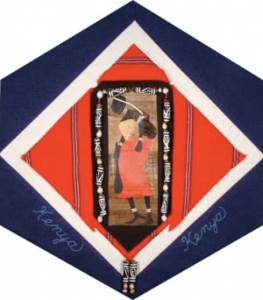Kenya

The Block
Sisters Jacqueline Nduta Mochai and Janice Wanjiku Mochai created an image of a Maasai woman, made of banana leaves for the Kenya block. On her back hangs a kiondo supported by a strap on her forehead to balance the weight of her goods. Kiondo are sisal, hemp or Baobab-fibre purses and baskets intricately hand-woven by the Kikuyu and Kamba women of Kenya. They are a world-renowned and practical art form used on a daily basis for carrying a range of items. A string of decorative black and white Shanga beads comprised of long beads carved from bone interspersed with tiny mineral stones mined in Kenya, and a mixture of wood and seed beads frame the woman and is symbolic of their importance within East African culture. Great emphasis is placed on appearance, thus elaborately beaded decorations are used extensively to embellish garments, as well as to beautify individuals. The block’s outer ‘wrap’ features hand-woven cloth draped to resemble the hooded-blankets typically worn by the Maasai people. Traditionally, these nomadic people will often sleep in the open wrapped in this type of blanket. Bright red is a favoured colour while the striped pattern is preferred by men.
Cultural Profile
Kenya (formerly British East Africa) is a country of many contrasts including lush rainforests and desert conditions, a beautiful coastline of sandy beaches and bush country, Nairobi (the capital city and largest in Eastern Africa) complete with skyscrapers and vast plains where lions, giraffes and cheetahs roam. The nation straddles the Equator, extending from Lake Victoria to the Indian Ocean, with highlands running through its central region divided by the Great Rift Valley, one of the wonders of the world. Some of the oldest human remains in the world were found in Kenya, said to be the cradle of humankind. They indicate that people have lived in this area for over three million years. The population is comprised of more than 40 ethnic groups, including the Kikuyu, Abaluhya, Luo and Maasai. Their ethnic diversity has produced many varied and rich cultural forms that reflect African, Asian, and European influences. English is the official language while Swahili (Ki-Swahili) is the national language, although there is also great linguistic diversity with close to 40 native languages and dialects spoken.
In Kenya, ethnic identity is more important than national identity. Family loyalty is central to all groups; members will give up individual rights in favour of group desires. Kenyans are hard-working individuals whose work ethic is described as kula jasho (eat from your labour).
Kenya’s most well-known ethnic group is arguably the Maasai people. The Maasai are semi-nomadic herdsmen who live close to Kenya’s national parks which are visited by many international tourists every year. Their traditional clothing of red cotton (used as a disguise in the bush) and their elaborate beaded jewellery have become one of the most recognized African ethnic costumes.
Music is one of the most popular art forms in the country, and often features songs that tell stories of family history, cultural events, wars, weddings and daily life. The most prominent style of home-grown music is benga, which originated among the Luo people of Western Kenya. Their traditional instruments include the nyatiti (four-stringed harp-like instrument) and the udi (similar to a sitar). Drama and dance are also favoured forms of artistic expression.
Kenyans are famous for their crafts including woodcarvings, makonde (ebony) and soapstone carvings. Jewelry is made from seashells, brass, beads, bone and gold. The kitenge is part of many women’s clothing. A batik cloth featuring bold and colourful designs, it is wrapped around the waist or the chest. It is also wrapped to serve as a headdress or used as a baby sling. The kanga is another typical garment worn. It consists of a piece of cloth measuring 1.5m x 1m, which features a border on each side, a central design and particularly, a proverb or a riddle in Swahili which is said to indicate something about the wearer’s mindset at the moment.
Many Kenyans who came to Canada settled in major cities because of employment opportunities. Their influence has touched many areas of Canadian society, most notably in the arts, music, clothing and cuisine. The 2011 census indicates there are now over 8,000 Kenyans living here though the number may be considerably larger. A number of significant African communities can be found throughout the country.
Sponsor: Sunrise Rotary Club of Cornwall
